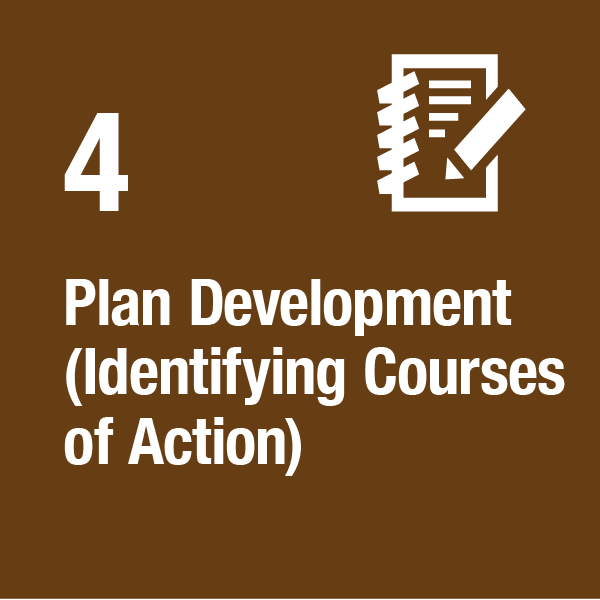Share Your Feedback
The REMS TA Center seeks your feedback to ensure that the Website is continually enhanced to meet your needs.
Step 4: Plan Development (Identifying Courses of Action)
In Step 4, the planning team develops courses of actions for accomplishing each of the objectives identified in Step 3 (for threats, hazards, and functions). Courses of action address the what, who, when, where, why, how for each threat, hazard, and function. The planning team should examine each course of action to determine whether it is feasible and whether the stakeholders necessary to implement it find it acceptable. For additional issues to consider as you develop courses of action for functions, please see the Plan Content section.
Identify Courses of Action
Courses of action include criteria for determining how and when each response will be implemented under a variety of circumstances. Subsequently, the planning team develops response protocols and procedures to support these efforts.
Possible courses of action are typically developed using the following steps:
- Depict the scenario. Create a potential scenario based on the threats and hazards identified and prioritized in Step 2.
- Determine the amount of time available to respond. This will vary based on the type of threat or hazard and the particular scenario. For example, in the case of a hurricane, the IHE might have days or hours to respond before the storm makes landfall, while the IHE may have to respond in minutes to an active shooter.
- Identify decision points. Decision points indicate the place in time, as threats or hazards unfold, when leaders anticipate making decisions about a course of action. Walking through each scenario in detail will help identify the relevant decision points for each one, such as whether or not to evacuate, shelter-in-place, or lockdown.
- Develop courses of action. Planners develop courses of action to achieve their goals and objectives by answering the following questions:
- What is the action?
- Who is responsible for the action?
- When does the action take place?
- How long does the action take and how much time is actually available?
- What has to happen before?
- What happens after?
- What resources are needed to perform the action?
- How will this action affect specific populations, such as individuals with disabilities and others with access and functional needs who may require medication, wayfinding, evacuation assistance, or personal assistance services, or who may experience severe anxiety during traumatic events?
Select Courses of Action
After developing courses of action, planners compare the costs and benefits of each proposed course of action against the goals and objectives. Based on this comparison, planners select the preferred course or courses of action to move forward in the planning process. Plans often include multiple courses of action for a given scenario to reflect the different ways it could unfold.
After selecting courses of action, the planning team identifies resources necessary to accomplish each course of action without regard to resource availability. Once the planning team identifies all of the requirements, it begins matching available resources to requirements. This step provides planners an opportunity to identify resource gaps or shortfalls that must be taken into account.
Step 4 Outcome
After completing Step 4, the planning team will have identified goals, objectives, and courses of action for before, during, and after threats and hazards, as well as functions.
Goals, objectives, and courses of action for threats and hazards will go into the Threat- and Hazard-Specific Annexes section of the higher ed EOP.
Goals, objectives, and courses of action for functions will be contained in the Functional Annexes section of the higher ed EOP.



